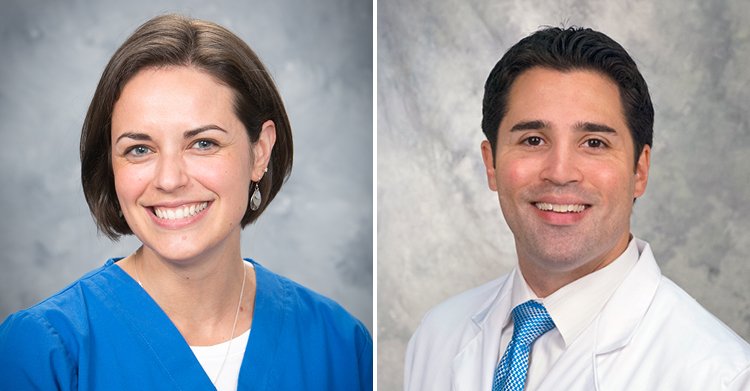Medical and Dental Alums Join Forces against a Rising Foe: Obstructive Sleep Apnea

Around 18 million people in the United States are affected by a potentially deadly disease: obstructive sleep apnea (OSA).
With cases of OSA on the rise—and a suspected 80 percent of Americans going undiagnosed—diagnosis and treatment are critical. Dr. Todd Falcone ’09 (MED), an otolaryngologist at UConn Health, and Dr. Lauren Mentasti ’09 (DENT), a general dentist in Avon, exemplify the kind of interdisciplinary approach that ensures patients have the happiest outcomes with this disease.
The common symptoms of OSA are snoring, daytime sleepiness, and restless, disrupted sleep—unsurprising, since the disease is characterized by repeated episodes of decreased or complete blockage in air flow during sleep. OSA is often due to collapse of the upper airways, including the soft tissues of the nose, mouth, or throat, and patients are often unaware that they literally stop breathing during the night. “During these ‘apneic’ episodes, a patient’s blood oxygen level can decrease, stressing the entire body—most notably the cardiovascular and respiratory systems,” Dr. Falcone explained. “And witnessing these breath-holding episodes is often quite disturbing to patients’ bed partners.”
Dr. Mentasti noted the devastating effects of OSA: “Left untreated, sleep apnea can lead to long-term problems such as hypertension, heart attack or failure, stroke, depression, cognitive impairment, and sexual dysfunction.”
Drs. Falcone and Mentasti met while attending UConn’s Medical and Dental Programs. At the completion of their training, they both settled in the Farmington Valley and reconnected professionally to help care for mutual patients with sleep apnea. Both are involved with the initial screening and diagnosis of OSA, but have different approaches to management of the disease depending on the patient’s specific disease profile and treatment wishes.
For patients suspected to be suffering from sleep apnea, Dr. Falcone first orders a sleep study, which can be performed either at home or in a certified sleep center. The overnight monitoring yields important data, measuring breathing, heart rate, limb movements, oxygen levels, and breath-holding episodes. The gold standard for treating OSA is continuous positive airway pressure (CPAP). When using CPAP, a patient wears a custom-fitted mask over their nose, mouth, or both while sleeping. The mask is attached to a machine that utilizes pressure to keep the airways open, thus preventing soft tissue collapse.
Dr. Falcone treats many patients with CPAP, but also specializes in surgery of the nose, mouth, and throat that may improve a patient’s sleep apnea depending on their unique anatomy. “Surgeries to improve nasal breathing include septoplasty, turbinate reduction, and sinus surgery,” he said. Other surgeries aim to increase the size of the airway in the mouth or throat, such as tonsillectomy, adenoidectomy, uvulectomy or uvulopalatopharyngoplasty (UPPP), during which both the tonsils and uvula are removed.
Dental professionals, like Dr. Mentasti, are part of an OSA patient’s healthcare team because they have a unique opportunity to screen for the disease, and can then collaborate with their medical colleagues on providing effective treatment. In addition to considering medical conditions and medications often associated with sleep apnea, a dentist may ask questions about snoring, daytime sleepiness, or quality of sleep to help determine whether a patient is at increased risk for this serious condition. “During a routine dental cleaning or exam, a dental professional is trained to evaluate the soft tissue architecture of the airway – including the neck, tongue, soft palate, tonsils, and uvula,” Dr. Mentasti said. “Dentists are also trained to look for other oral signs of OSA, such as teeth grinding and acid erosion.”
While CPAP is usually well tolerated and often curative for patients, those with mild or moderate OSA may receive best results with a non-invasive oral appliance. Fabricated by an experienced dentist, Dr. Mentasti noted, it is an acceptable first-line treatment, and may be an alternative option for those intolerant to CPAP. “The appliance repositions the lower jaw down and forward, opening the soft tissues of the airway, preventing airway collapse during sleep, and allowing for air to pass more freely,” Dr. Mentasti said, adding that patients must work closely with a dental professional to adjust the appliance. Proper fitting and titration of the device can maximize its effectiveness in treating the airway issue, while minimizing potential side effects to the temporomandibular joint (TMJ).
Untreated sleep apnea dramatically affects patients’ quality of life, can reduce life expectancy, and can be dangerous when chronically sleep-deprived people are behind the wheel. OSA increases patients’ risk for hypertension, heart disease, hormone imbalances, weight gain, and depression.
“As members of the healthcare community, we all have a responsibility to educate ourselves on obstructive sleep apnea so that we can effectively screen our patients and provide them with resources to seek the help that they need,” Dr. Mentasti said.
“It is essential for physicians and dentists alike to effectively communicate and collaborate for the benefit of our mutual patients,” Dr. Falcone added. “Our patients’ lives may depend on it.”
